Dequan Wang
MedForge: Building Medical Foundation Models Like Open Source Software Development
Feb 22, 2025Abstract:Foundational models (FMs) have made significant strides in the healthcare domain. Yet the data silo challenge and privacy concern remain in healthcare systems, hindering safe medical data sharing and collaborative model development among institutions. The collection and curation of scalable clinical datasets increasingly become the bottleneck for training strong FMs. In this study, we propose Medical Foundation Models Merging (MedForge), a cooperative framework enabling a community-driven medical foundation model development, meanwhile preventing the information leakage of raw patient data and mitigating synchronization model development issues across clinical institutions. MedForge offers a bottom-up model construction mechanism by flexibly merging task-specific Low-Rank Adaptation (LoRA) modules, which can adapt to downstream tasks while retaining original model parameters. Through an asynchronous LoRA module integration scheme, the resulting composite model can progressively enhance its comprehensive performance on various clinical tasks. MedForge shows strong performance on multiple clinical datasets (e.g., breast cancer, lung cancer, and colon cancer) collected from different institutions. Our major findings highlight the value of collaborative foundation models in advancing multi-center clinical collaboration effectively and cohesively. Our code is publicly available at https://github.com/TanZheling/MedForge.
Lost in Translation: Latent Concept Misalignment in Text-to-Image Diffusion Models
Aug 05, 2024Abstract:Advancements in text-to-image diffusion models have broadened extensive downstream practical applications, but such models often encounter misalignment issues between text and image. Taking the generation of a combination of two disentangled concepts as an example, say given the prompt "a tea cup of iced coke", existing models usually generate a glass cup of iced coke because the iced coke usually co-occurs with the glass cup instead of the tea one during model training. The root of such misalignment is attributed to the confusion in the latent semantic space of text-to-image diffusion models, and hence we refer to the "a tea cup of iced coke" phenomenon as Latent Concept Misalignment (LC-Mis). We leverage large language models (LLMs) to thoroughly investigate the scope of LC-Mis, and develop an automated pipeline for aligning the latent semantics of diffusion models to text prompts. Empirical assessments confirm the effectiveness of our approach, substantially reducing LC-Mis errors and enhancing the robustness and versatility of text-to-image diffusion models. The code and dataset are here: https://github.com/RossoneriZhao/iced_coke.
Dissecting Dissonance: Benchmarking Large Multimodal Models Against Self-Contradictory Instructions
Aug 05, 2024

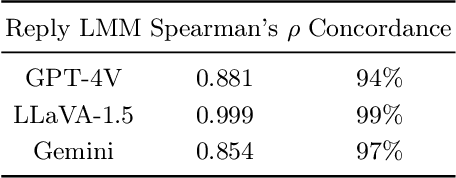

Abstract:Large multimodal models (LMMs) excel in adhering to human instructions. However, self-contradictory instructions may arise due to the increasing trend of multimodal interaction and context length, which is challenging for language beginners and vulnerable populations. We introduce the Self-Contradictory Instructions benchmark to evaluate the capability of LMMs in recognizing conflicting commands. It comprises 20,000 conflicts, evenly distributed between language and vision paradigms. It is constructed by a novel automatic dataset creation framework, which expedites the process and enables us to encompass a wide range of instruction forms. Our comprehensive evaluation reveals current LMMs consistently struggle to identify multimodal instruction discordance due to a lack of self-awareness. Hence, we propose the Cognitive Awakening Prompting to inject cognition from external, largely enhancing dissonance detection. The dataset and code are here: https://selfcontradiction.github.io/.
Direct Preference Knowledge Distillation for Large Language Models
Jun 28, 2024



Abstract:In the field of large language models (LLMs), Knowledge Distillation (KD) is a critical technique for transferring capabilities from teacher models to student models. However, existing KD methods face limitations and challenges in distillation of LLMs, including efficiency and insufficient measurement capabilities of traditional KL divergence. It is shown that LLMs can serve as an implicit reward function, which we define as a supplement to KL divergence. In this work, we propose Direct Preference Knowledge Distillation (DPKD) for LLMs. DPKD utilizes distribution divergence to represent the preference loss and implicit reward function. We re-formulate KD of LLMs into two stages: first optimizing and objective consisting of implicit reward and reverse KL divergence and then improving the preference probability of teacher outputs over student outputs. We conducted experiments and analysis on various datasets with LLM parameters ranging from 120M to 13B and demonstrate the broad applicability and effectiveness of our DPKD approach. Meanwhile, we prove the value and effectiveness of the introduced implicit reward and output preference in KD through experiments and theoretical analysis. The DPKD method outperforms the baseline method in both output response precision and exact match percentage. Code and data are available at https://aka.ms/dpkd.
mmPlace: Robust Place Recognition with Intermediate Frequency Signal of Low-cost Single-chip Millimeter Wave Radar
Mar 07, 2024Abstract:Place recognition is crucial for tasks like loop-closure detection and re-localization. Single-chip millimeter wave radar (single-chip radar in short) emerges as a low-cost sensor option for place recognition, with the advantage of insensitivity to degraded visual environments. However, it encounters two challenges. Firstly, sparse point cloud from single-chip radar leads to poor performance when using current place recognition methods, which assume much denser data. Secondly, its performance significantly declines in scenarios involving rotational and lateral variations, due to limited overlap in its field of view (FOV). We propose mmPlace, a robust place recognition system to address these challenges. Specifically, mmPlace transforms intermediate frequency (IF) signal into range azimuth heatmap and employs a spatial encoder to extract features. Additionally, to improve the performance in scenarios involving rotational and lateral variations, mmPlace employs a rotating platform and concatenates heatmaps in a rotation cycle, effectively expanding the system's FOV. We evaluate mmPlace's performance on the milliSonic dataset, which is collected on the University of Science and Technology of China (USTC) campus, the city roads surrounding the campus, and an underground parking garage. The results demonstrate that mmPlace outperforms point cloud-based methods and achieves 87.37% recall@1 in scenarios involving rotational and lateral variations.
OpenMEDLab: An Open-source Platform for Multi-modality Foundation Models in Medicine
Mar 04, 2024



Abstract:The emerging trend of advancing generalist artificial intelligence, such as GPTv4 and Gemini, has reshaped the landscape of research (academia and industry) in machine learning and many other research areas. However, domain-specific applications of such foundation models (e.g., in medicine) remain untouched or often at their very early stages. It will require an individual set of transfer learning and model adaptation techniques by further expanding and injecting these models with domain knowledge and data. The development of such technologies could be largely accelerated if the bundle of data, algorithms, and pre-trained foundation models were gathered together and open-sourced in an organized manner. In this work, we present OpenMEDLab, an open-source platform for multi-modality foundation models. It encapsulates not only solutions of pioneering attempts in prompting and fine-tuning large language and vision models for frontline clinical and bioinformatic applications but also building domain-specific foundation models with large-scale multi-modal medical data. Importantly, it opens access to a group of pre-trained foundation models for various medical image modalities, clinical text, protein engineering, etc. Inspiring and competitive results are also demonstrated for each collected approach and model in a variety of benchmarks for downstream tasks. We welcome researchers in the field of medical artificial intelligence to continuously contribute cutting-edge methods and models to OpenMEDLab, which can be accessed via https://github.com/openmedlab.
An Extensible Framework for Open Heterogeneous Collaborative Perception
Jan 25, 2024



Abstract:Collaborative perception aims to mitigate the limitations of single-agent perception, such as occlusions, by facilitating data exchange among multiple agents. However, most current works consider a homogeneous scenario where all agents use identity sensors and perception models. In reality, heterogeneous agent types may continually emerge and inevitably face a domain gap when collaborating with existing agents. In this paper, we introduce a new open heterogeneous problem: how to accommodate continually emerging new heterogeneous agent types into collaborative perception, while ensuring high perception performance and low integration cost? To address this problem, we propose HEterogeneous ALliance (HEAL), a novel extensible collaborative perception framework. HEAL first establishes a unified feature space with initial agents via a novel multi-scale foreground-aware Pyramid Fusion network. When heterogeneous new agents emerge with previously unseen modalities or models, we align them to the established unified space with an innovative backward alignment. This step only involves individual training on the new agent type, thus presenting extremely low training costs and high extensibility. It also protects new agents' model details from disclosure since the training can be conducted by the agent owner locally. To enrich agents' data heterogeneity, we bring OPV2V-H, a new large-scale dataset with more diverse sensor types. Extensive experiments on OPV2V-H and DAIR-V2X datasets show that HEAL surpasses SOTA methods in performance while reducing the training parameters by 91.5% when integrating 3 new agent types. Code and data are available at: https://github.com/yifanlu0227/HEAL.
Data-Centric Foundation Models in Computational Healthcare: A Survey
Jan 04, 2024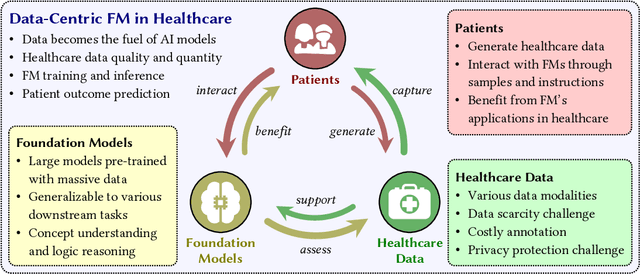
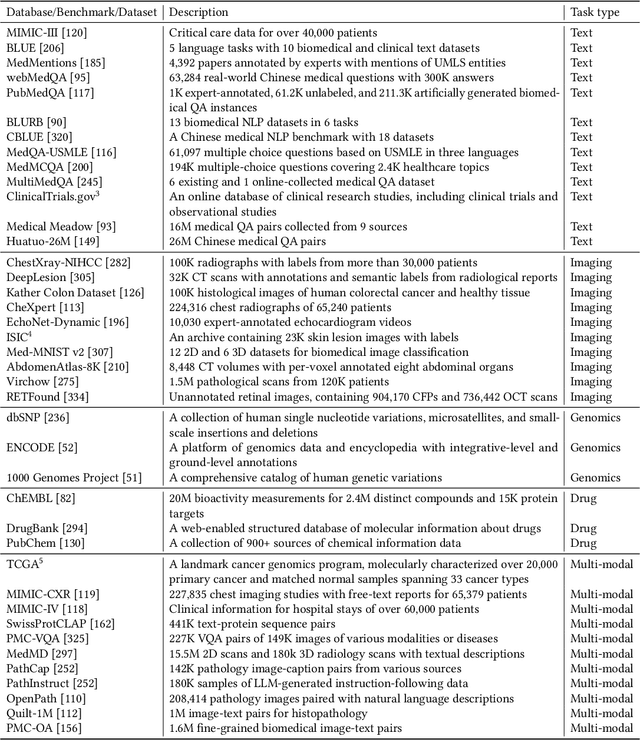
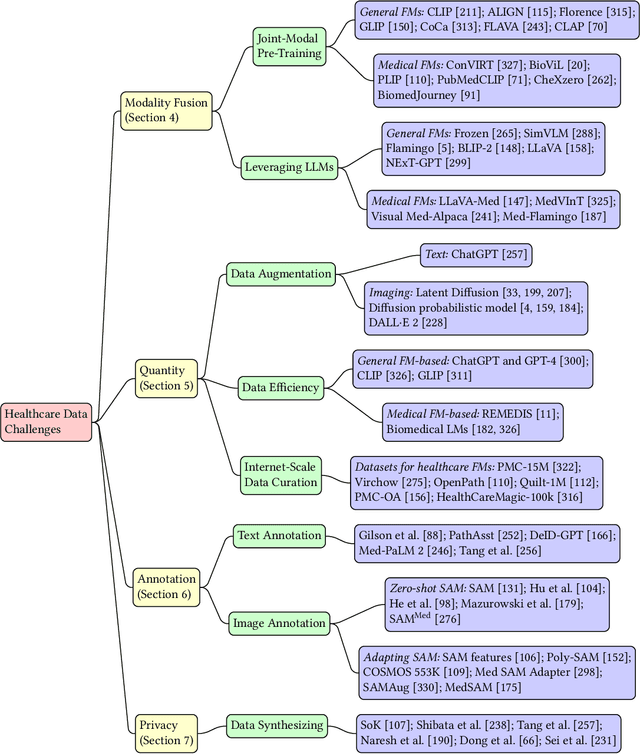
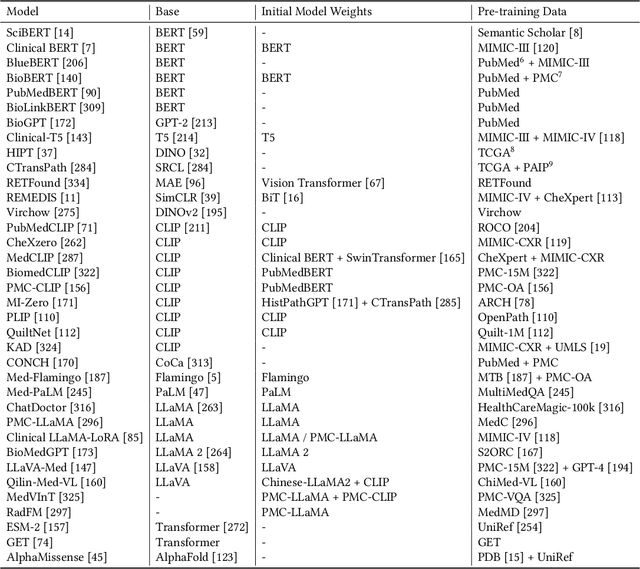
Abstract:The advent of foundation models (FMs) as an emerging suite of AI techniques has struck a wave of opportunities in computational healthcare. The interactive nature of these models, guided by pre-training data and human instructions, has ignited a data-centric AI paradigm that emphasizes better data characterization, quality, and scale. In healthcare AI, obtaining and processing high-quality clinical data records has been a longstanding challenge, ranging from data quantity, annotation, patient privacy, and ethics. In this survey, we investigate a wide range of data-centric approaches in the FM era (from model pre-training to inference) towards improving the healthcare workflow. We discuss key perspectives in AI security, assessment, and alignment with human values. Finally, we offer a promising outlook of FM-based analytics to enhance the performance of patient outcome and clinical workflow in the evolving landscape of healthcare and medicine. We provide an up-to-date list of healthcare-related foundation models and datasets at https://github.com/Yunkun-Zhang/Data-Centric-FM-Healthcare .
BayesDiff: Estimating Pixel-wise Uncertainty in Diffusion via Bayesian Inference
Oct 17, 2023



Abstract:Diffusion models have impressive image generation capability, but low-quality generations still exist, and their identification remains challenging due to the lack of a proper sample-wise metric. To address this, we propose BayesDiff, a pixel-wise uncertainty estimator for generations from diffusion models based on Bayesian inference. In particular, we derive a novel uncertainty iteration principle to characterize the uncertainty dynamics in diffusion, and leverage the last-layer Laplace approximation for efficient Bayesian inference. The estimated pixel-wise uncertainty can not only be aggregated into a sample-wise metric to filter out low-fidelity images but also aids in augmenting successful generations and rectifying artifacts in failed generations in text-to-image tasks. Extensive experiments demonstrate the efficacy of BayesDiff and its promise for practical applications.
Text-guided Foundation Model Adaptation for Pathological Image Classification
Jul 27, 2023



Abstract:The recent surge of foundation models in computer vision and natural language processing opens up perspectives in utilizing multi-modal clinical data to train large models with strong generalizability. Yet pathological image datasets often lack biomedical text annotation and enrichment. Guiding data-efficient image diagnosis from the use of biomedical text knowledge becomes a substantial interest. In this paper, we propose to Connect Image and Text Embeddings (CITE) to enhance pathological image classification. CITE injects text insights gained from language models pre-trained with a broad range of biomedical texts, leading to adapt foundation models towards pathological image understanding. Through extensive experiments on the PatchGastric stomach tumor pathological image dataset, we demonstrate that CITE achieves leading performance compared with various baselines especially when training data is scarce. CITE offers insights into leveraging in-domain text knowledge to reinforce data-efficient pathological image classification. Code is available at https://github.com/Yunkun-Zhang/CITE.
 Add to Chrome
Add to Chrome Add to Firefox
Add to Firefox Add to Edge
Add to Edge